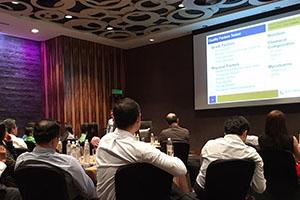The cities of Jakarta, Kuala Lumpur, Hanoi, Ho Chi Minh City and Bangkok all played host to seminars targeting feed formulators and regional importers over the last two weeks, part of roadshows put on by the U.S. Grains Council’s office in Kuala Lumpur, Malaysia.
Robust feed demand growth and import arbitrages have lead Southeast Asia to become a major destination for both corn and distiller’s dried grains with solubles (DDGS) in recent years. Collectively, the region’s DDGS imports through May are up 74 percent according to U.S. Department of Agriculture (USDA) data and have overtaken Mexico as the second largest importer of the corn based ethanol co-product.
Building on this momentum, the Council invited DDGS nutritionist Dr. Gerald Shurson of the University of Minnesota to the region to help formulators push DDGS inclusion to the maximum limits, given favorable economics.
“In Vietnam, we’ve learned that major feed companies and integrators are using DDGS up to 20 percent in poultry diets, but only 10 percent in swine diets. This is surprising because in the U.S., 20 percent diet inclusion rates are common for swine, with 5 to 9 percent inclusion rates for broilers,” Shurson said.
Vietnam is the third largest market for DDGS with a rapidly-developing feed industry. Opportunity for higher inclusion rations, particularly on the swine side – the meat of choice for the Vietnamese – presents an exciting challenge for USGC stakeholders.
“When Vietnamese DDGS users are pressed for reasons why they are not using higher dietary inclusion rates for swine, they have responded it is because they don’t have confidence in the energy and digestible amino acid values for use in feed formulation,” Shurson said. “We’ve worked to address these topics in seminars and site visits sharing the latest information and nutritional approaches to deal with variability in crude fat content and color.”
The roadshows also focused on promoting U.S.-origin corn, as logistics and prices are unusually favorable for U.S.-origin loadings. Typically, the United States suffers from unfavorable freight spreads compared with South America, but historically low freight rates have marginalized that advantage and FOB-to-FOB values now favor the U.S. This dynamic and logistics backlogs in South America have buyers looking once again to the United States to supply their corn needs.
Despite the favorable economics, Southeast Asian buyers have developed a strong preference for South American corn, which has permeated into a “required discount” for U.S. origin corn. The Council’s programs in the region are focused on changing the behavior of Southeast Asia importers so they include the U.S. in their supply pipelines when economics indicate. The Council is doing this by aggressively promoting its annual corn quality reports in addition to nutritional servicing by respected academics like Shurson.
“My ultimate goal is for DDGS to become a ubiquitous component of all SEA feed formulations and U.S. corn to be the origin of first resort,” said Kevin Roepke, regional director for the U.S. Grains Council. “Given our strong promotional programs, we should see a surge of U.S.-origin shipments to the region to finish out old crop, followed by a turning point for sales into the region with the high-quality new crop.”


